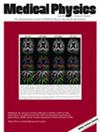Towards an adequate description of the dose-response relationship in BNCT of glioblastoma multiforme
Abstract
Background
Boron Neutron Capture Therapy (BNCT) is a binary radiotherapy based on the intravenous administration of a borated drug to the patient and the subsequent irradiation with a low-energy neutron beam. The borated formulation accumulates in the tumor cells, and when neutrons interact with boron, a nuclear capture reaction occurs, releasing high-linear energy transfer, short-range particles that cause lethal damage to the cancer cells. Due to its selectivity, BNCT has the potential to treat aggressive brain tumors such as glioblastoma multiforme (GBM), minimizing the side effects. GBM is a brain neoplasia that poses significant treatment challenges due to its invasiveness and resistance to conventional treatments.
Purpose
This work aims to find a suitable model for calculating the photon isoeffective dose for GBM, producing ad hoc radiobiological data to feed the model.
Methods
- 1. We studied the impact of choosing two different photon radiation types (x- or gamma- rays)
- 2. We assumed that the correct description of the photon-equivalent dose is obtained with the photon isoeffective dose model. This model calculates the photon dose that equals the cell survival obtained with BNCT, taking into account synergism and sub-lethal damage (SLD).
- 3. Survival curves as a function of the dose for the human GBM U87 cell line were constructed using the clonogenic assays for irradiation with photons (reference), neutron beam, and BNCT.
- 4. Survival curves were fitted with the modified linear quadratic model, using SLD repair times derived for U87. The radiobiological parameters were determined for the photon isoeffective dose model.
- 5. The model was applied to a clinical case that received BNCT in Taiwan. Treatment planning has been simulated using an accelerator-based designed neutron beam following the real treatment process and parameters. The results were discussed and compared to the current method, which employs relative biological effectiveness (RBE) factors to obtain BNCT dosimetry in photon-equivalent units.
Results
The dose-survival curves have been obtained with two different photon radiation sources as the reference with a thermal neutron beam and neutrons in the presence of boron. The fitted parameters have been obtained as the input for the photon isoeffective dose and the traditional RBE model. For the first time, the radiobiological parameters of a photon isoeffective dose model were produced for BNCT of GBM. Photon isoeffective dose value can differ up to 32% using gamma photons and low-energy x-rays. Photon isoeffective dose values are lower (17%) than the RBE model currently employed in clinical trials.
Conclusion
The results highlight the impact of the reference radiation chosen for the isoeffective dose calculation and the importance of feeding the model with the appropriate radiobiological parameters.The dosimetry obtained with the new radiobiological data is consistent with the dose delivered in modern stereotactic radiotherapy, enabling tumor control predictions.


 求助内容:
求助内容: 应助结果提醒方式:
应助结果提醒方式:


